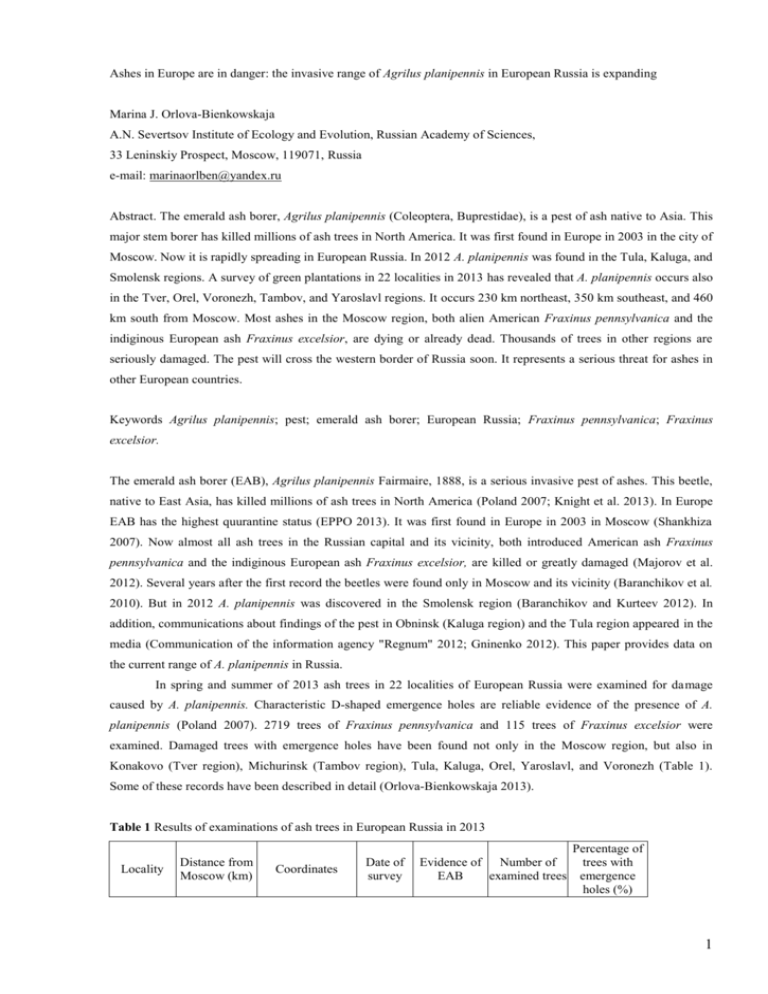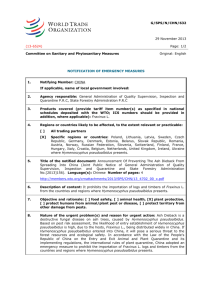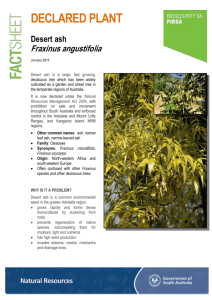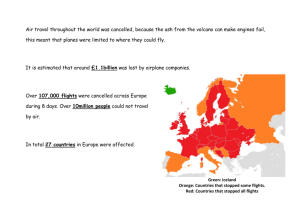orlbien2013agrilus
advertisement

Ashes in Europe are in danger: the invasive range of Agrilus planipennis in European Russia is expanding Marina J. Orlova-Bienkowskaja A.N. Severtsov Institute of Ecology and Evolution, Russian Academy of Sciences, 33 Leninskiy Prospect, Moscow, 119071, Russia e-mail: marinaorlben@yandex.ru Abstract. The emerald ash borer, Agrilus planipennis (Coleoptera, Buprestidae), is a pest of ash native to Asia. This major stem borer has killed millions of ash trees in North America. It was first found in Europe in 2003 in the city of Moscow. Now it is rapidly spreading in European Russia. In 2012 A. planipennis was found in the Tula, Kaluga, and Smolensk regions. A survey of green plantations in 22 localities in 2013 has revealed that A. planipennis occurs also in the Tver, Orel, Voronezh, Tambov, and Yaroslavl regions. It occurs 230 km northeast, 350 km southeast, and 460 km south from Moscow. Most ashes in the Moscow region, both alien American Fraxinus pennsylvanica and the indiginous European ash Fraxinus excelsior, are dying or already dead. Thousands of trees in other regions are seriously damaged. The pest will cross the western border of Russia soon. It represents a serious threat for ashes in other European countries. Keywords Agrilus planipennis; pest; emerald ash borer; European Russia; Fraxinus pennsylvanica; Fraxinus excelsior. The emerald ash borer (EAB), Agrilus planipennis Fairmaire, 1888, is a serious invasive pest of ashes. This beetle, native to East Asia, has killed millions of ash trees in North America (Poland 2007; Knight et al. 2013). In Europe EAB has the highest quurantine status (EPPO 2013). It was first found in Europe in 2003 in Moscow (Shankhiza 2007). Now almost all ash trees in the Russian capital and its vicinity, both introduced American ash Fraxinus pennsylvanica and the indiginous European ash Fraxinus excelsior, are killed or greatly damaged (Majorov et al. 2012). Several years after the first record the beetles were found only in Moscow and its vicinity (Baranchikov et al. 2010). But in 2012 A. planipennis was discovered in the Smolensk region (Baranchikov and Kurteev 2012). In addition, communications about findings of the pest in Obninsk (Kaluga region) and the Tula region appeared in the media (Communication of the information agency "Regnum" 2012; Gninenko 2012). This paper provides data on the current range of A. planipennis in Russia. In spring and summer of 2013 ash trees in 22 localities of European Russia were examined for damage caused by A. planipennis. Characteristic D-shaped emergence holes are reliable evidence of the presence of A. planipennis (Poland 2007). 2719 trees of Fraxinus pennsylvanica and 115 trees of Fraxinus excelsior were examined. Damaged trees with emergence holes have been found not only in the Moscow region, but also in Konakovo (Tver region), Michurinsk (Tambov region), Tula, Kaluga, Orel, Yaroslavl, and Voronezh (Table 1). Some of these records have been described in detail (Orlova-Bienkowskaja 2013). Table 1 Results of examinations of ash trees in European Russia in 2013 Locality Distance from Moscow (km) Coordinates Date of survey Evidence of Number of EAB examined trees Percentage of trees with emergence holes (%) 1 F. pennsylvanica F. excelsior F. pennsylvanica F. excelsior Kaluga 145 54.52 N, 36.26 E Junе 3 Emergence holes 128 0 15.6 0 Klin 70 56.33 N, 36.73 E May 25 Emergence holes 88 0 98.9 0 Konakovo 100 56.71 N, 36.77 E May 20 Emergence holes 128 0 88.3 0 Michurinsk 350 52.90 N, 40.50 E June 28 Emergence holes 11 4 54.5 0 Uzunovo 135 54.55 N, 38.62 E June 29 Emergence holes 53 0 100 0 Monino 20 55.84 N, 38.20 E June 21 Emergence holes, 1 adult 112 0 98.2 0 Orel 310 52.97 N, 36.07 E June 4 Emergence holes, 1 adult 193 14 48.2 57.1 Tula 150 54.20 N, 37.62 E June 5 Emergence holes, 1 adult 124 3 10.5 100 Voronezh 460 51.68 N, 39.18 E June 12 Emergence holes, 1 adult 110 1 52.7 100 Yaroslavl 230 57.63 N, 39.87 E June 30 Emergence holes, 1 adult 219 0 21.9 0 0 95.6 0 0 94.5 0 Zelenograd 20 Staraya Kupavna 20 Bryansk Gryazi Kostroma Lipetsk Nizhniy Novgorod Rostov-onDon Ryazan Tambov Tver Vladimir Emergence holes, 26 adults captured from 55.99 N, 37.20 E May–July June 8 to July 161 5, 20 larvae captured August 20 and 22 Emergence 55.81 N, 38.18 E June 21 holes, 5 109 adults 330 380 285 350 53.25 N, 34.40 E 52.49 N, 39.93 E 57.77 N, 40.94 E 52.60 N, 39.59 E 375 June 3 June 27 July 16 June 27 No No No No 159 40 140 195 0 0 0 1 0 0 0 0 0 0 0 0 56.32 N, 44.00 E August 14 No 99 4 0 0 950 47.23 N, 39.72 E No 83 84 0 0 165 400 145 160 54.62 N, 39.74 E June 29 52.72 N, 41.45 E June 28 56.86 N, 35.91 E May 25 56.14 N, 40.41 E August 15 No No No No 128 175 144 120 0 3 0 1 0 0 0 0 0 0 0 0 June 14 2 In 2013, adults of A. planipennis were captured from June 8 to July 5. At the end of August larvae of the second instar and prepupae were found under the bark (identified after Chamorro et al. 2012). It may indicate that the beetle completes its life cycle in more than one year. In China and North America, the beetle completes its life cycle in one or two years depending on the climate (Wei et al. 2007; Mastro et al. 2007). A. planipennis has often been found infesting ash trees along with the bark beetle Hylesinus fraxini (Panzer 1779). (Coleoptera: Scolytidae) (Izhevskiy 2007), Agrilus convexicollis Redtenbacher, 1849 (Coleoptera: Buprestidae), and Tetrops starkii Chevrolat, 1859 (Coleoptera: Cerambycidae) (original data). In all examined localities of the Moscow region, as well as in the city of Konakovo (Tver region), most of the ash trees have already been killed by the EAB. Most ash trees in Kaluga, Orel, Tula, Yaroslavl, Michurinsk, and Voronezh appear healthy, but groups of damaged and dying trees with characteristic emergence holes are present. No signs of A. planipennis were found in other 10 localities. Data on the distribution of A. planipennis are summarized in the map (Fig. 1) and in Table 2. Fig. 1 The invasive range of A. planipennis in European Russia. Black dots indicate localities where A. planipennis has been found. White dots with a point are localities where examinations were performed but A. planipennis was not found. Sources of information are listed in Table 2. Table 2 Localities where A. planipennis has been found in European Russia Region The year of first record Source of information Moscow 2003 (Shankhiza 2007) Istra District: Manikhino 2006 (Volkovich 2007) MOSCOW REGION 3 Mozhaisk District 2009 (Baranchikov et al. 2010) Serpukhov 2009 (Baranchikov et al. 2010) Mytistchi 2009 (Baranchikov et al. 2010) Pushkino 2009 (Baranchikov and Kurteev 2012) Zelenograd 2011 Original data Sergiev Posad 2012 (Baranchikov and Kurteev 2012) Klin 2013 Original data Kolomna 2012 (Lifant'eva 2012) Noginsk District: Staraya Kupavna 2013 Original data Shchelkovo District: Monino 2013 Original data 2013 Original data Gagarin District 2012 (Baranchikov and Kurteev 2012) Vyazma District 2012 (Baranchikov and Kurteev 2012) 2013 Original data Obninsk 2012 (Communication of the information agency "Regnum" 2012) Kaluga 2013 Original data 2013 Original data 2013 Original data 2013 Original data 2013 Original data 2013 Original data Serebryanye Prudy District: Uzunovo SMOLENSK REGION TVER REGION Konakovo KALUGA REGION OREL REGION Orel TULA REGION Tula VORONEZH REGION Voronezh YAROSLAVL REGION Yaroslavl TAMBOV REGION Michurinsk Currently, the westernmost known locality of the species is 250 km from Moscow (Baranchikov and Kurteev 2012). According to our data, the most northern locality of the species is Yaroslavl (230 km northeast from Moscow), the most eastern is Michurinsk (350 km southeast from Moscow), and the most southern is Voronezh (460 km south from Moscow). Adults of A. planipennis fly well, but can spread only 6–10 km per year by themselves (Mercader et al. 2009). How could the beetles spread over 460 km within only 10 years after the first record in Moscow? First, the beetle could have appeared in European Russia earlier. Second, long-distance humanassisted spread is quite possible. In America, natural spread is of minor importance compared to human-assisted movement (Poland 2007). It is interesting that A. planipennis was found in Michurinsk near the union railway station, while it was not found in the four nearest cities. This may indicate that the beetle was spread by transport. 4 The invasive range of A. planipennis is expanding rapidly. Within ten years after the first record in Moscow this pest has spread to at least nine regions of the Russian Federation. The area of its invasive range is at least 150 000 km2 (i.e., it exceeds the area of England). Agrilus planipennis has been found as far as 460 km from Moscow, while the distance between the most western point of known range and the western border of the Russian Federation is about 180 km. Considering that ash species occur all over Europe, there is no reason to doubt that A. planipennis will eventually spread to other European regions. Baranchikov and Kurteev (2012) suggested that it would cross the western border of Russia and appear in adjacent countries before 2020. The present data strongly confirm this suggestion. The first recorded infestations of A. planipennis in European Russia were observed on F. pennsylvanica (Volkovich 2007; Mozolevskaya et al. 2008) because this ash species introduced from America largely dominates in Russian cities, with European ash F. excelsior being occasionally planted. It was initially unclear whether F. excelsior was susceptible to the pest (Baranchikov et al. 2008). Now it is understood that F. excelsior is indeed susceptible: almost all Fraxinus excelsior in Moscow and its vicinity have been killed or greatly damaged (Majorov et al. 2012), and the present survey revealed that A. planipennis also damages F. excelsior in other regions, including Orel, Voronezh, and Tula. The current situation with A. planipennis in European Russia is quite similar to the situation in North America. Obviously, A. planipennis will cross the western border of Russia and appear in other countries soon. As the pest kills both F. pennsylvanica and F. excelsior, it represents a serious threat for ashes in Europe and, indirectly, to the European economy and environment. Acknowledgments I am grateful to M.G. Volkovich (Zoological Institute, Russian Academy of Sciences) for the confirmation of the beetle identification. The research is supported by the Program of Presidium of Russian Academy of Sciences "Wildlife" – "Invasions". References Baranchikov YN, Gninenko YI, Yurchenko GI (2010) Emerald ash borer in Russia: 2009 situation update. Proceedings of the 21st USDA Interagency research forum on invasive species. USDA FS APHIS, Morgantown, pp 66–67 Baranchikov YN, Kurteev VV (2012) Invasive area of the emerald ash borer in Europe. Ecological and economical consequences of invasions of dendrophilous insects. Forest Institute of Siberian Branch of Russian Academy of Sciences, Krasnoyarsk, pp 91–94 (in Russian) Baranchikov YN, Mozolevskaya EG, Yurchenko GI, Kenis M (2008) Occurrence of the emerald ash borer (Agrilus planipennis) in Russia and its potential impact on European forestry. EPPO Bull. 38:233–238 Chamorro ML, Volkovitsh MG, Poland TM, Haack RA, Lingafelter SW (2012) Preimaginal Stages of the Emerald Ash Borer, Agrilus planipennis Fairmaire (Coleoptera: Buprestidae): An Invasive Pest on Ash Trees (Fraxinus). PLoS ONE 7(3): e33185. doi:10.1371/journal.pone.0033185 Communication of the information agency "Regnum" (2012) The beetle that has damaged trees in the vicinity of Moscow damages trees in Obninsk (Kaluga region) http://www.regnum.ru/news/ecology/1567880.html (in Russian). Accessed 22 May 2013 EPPO (2013) European and Mediterranean Plant Protection Organization. Database on quarantine pests http://www.eppo.int/DATABASES/pqr/pqr.htm. Accessed 20 September 2013 5 Gninenko YI (2012) Report of the operative meeting of Federal Forestry Agency (21.08.2012). Federal Forestry Agency 2012 http://www.rosleshoz.gov.ru/media/stenogramm/27 (in Russian). Accessed 25 May 2013 Izhevskiy SS (2007) Invasion of the emerald ash borer Agrilus planipennis in Moscow region. http://www.zin.ru/Animalia/Coleoptera/rus/agrplaiz.htm (in Russian). Accessed 25 May 2013 Knight KS, Brown JP, Long RP (2013) Factors affecting the survival of ash (Fraxinus spp.) trees infested by emerald ash borer (Agrilus planipennis) Biol Invasions 15:371–383. doi 10.1007/s10530-012-0292-z Lifant’eva E (2012) Interview with the head of Department of ecology of the city administration V.I. Slobodenyuk. Ugol zreniya, 22 (597) http://uz.colomna.ru/rubric/localtime/3614.html (in Russian). Accessed 22 June 2013 Majorov SR, Bochkin VD, Nasimovich YA, Shcherbakov AV (2012) Alien flora of Moscow and Moscow region. KMK Publishing house, Moscow Mastro V, Lance D, Reardon R, Parra G (2007) Emerald Ash Borer and Asian Longhorned Beetle Research and Technology Development Meeting. Cincinnati, OH, October 29-November 2, 2006. USDA Forest Service FHTET-2007-04 Mercader RJ, Siegert NW, Liebhold AM, McGullough DG (2009) Emerald ash borer, Agrilus planipennis, dispersal in newly colonized sites Agric. For. Entomol. 11:421–424 Mozolevskaya EG, Izmailov AI, Alexeyev NA (2008) Foci of the dangerous pest of ash – emerald ash borer in Moscow and vicinity. Forest Vestnik 53:24–31 (in Russian) Orlova-Bienkowskaja MJ (2013, in press) Dramatic expansion of the range of invasive ash pest Agrilus planipennis Fairmaire, 1888 (Coleoptera: Buprestidae) in European Russia. Entomol. Rev. 93 (4) (in Russian) Poland TM (2007) Twenty million ash trees later: current status of Emerald ash borer in Michigan. Newsletter of the Michigan Entomological Society 52 (1-2):10–14 Shankhiza EV (2007) Invasion of the emerald ash borer Agrilus planipennis to Moscow region http://www.zin.ru/Animalia/Coleoptera/rus/fraxxx.htm (in Russian). Accessed 24 May 2013 Volkovich MG (2007) Emerald ash borer Agrilus planipennis – new extremely dangerous pest of ash in the European part of Russia http://www.zin.ru/Animalia/Coleoptera/rus/eab_2007.htm (in Russian). Accessed 25 June 2013 Wei X, Wu Y, Reardon R, Sun TH, Lu M, Sun JH (2007) Biology and damage traits of emerald ash borer (Agrilus planipennis Fairmaire) in China. Insect Sci. 14 (5):367–373 6








